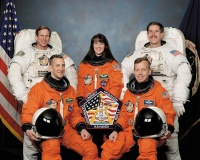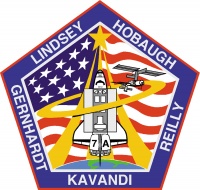STS-104
From The Space Library
 | |
| Organization | NASA-Office of Space Flight (United States) |
|---|---|
| Mission type | Engineering,Human Crew |
| Launch date | July 12, 2001 |
| Launch vehicle | Space Shuttle |
| Launch site | Cape Canaveral, United States |
| COSPAR ID | 2001-028A |
| Inclination | 51.6 degrees |
| Experiments | Here |
| Alternate Names | 26862 |
| Additional Information | Here |
| Data Collection | Here |
| Payload Mass Up | 11985.72 kg |
| Payload Mass Down | 3303.64 kg |
| Orbiter | Atlantis |
| Lift Off Mass | 2,054,617.73 kg |
| Orbiter Weight at Liftoff | 119,523.64 kg |
| Orbiter Weight at Landing | 94,046.36 kg |
| Landed | Concrete runway 15 at Kennedy Space Center, Fla. |
| Orbits of Earth | 200 |
| Orbital Altitude | 240 nautical miles |
Contents |
[edit] Crew
- Commander: Steven W. Lindsey
- Pilot: Charles O. Hobaugh
- Payload Commander:
- Mission Specialist 1: Michael L. Gernhardt
- Mission Specialist 2: James F. Reilly
- Mission Specialist 3: Janet L. Kavandi
- Mission Specialist 4:
- Mission Specialist 5:
- Payload Specialist 1:
- Payload Specialist 2:
ISS/Mir Crew Transport
[edit] Mission
STS 104 is an American shuttle spacecraft that was launched from Cape Canaveral at 09:04 UT on 12 July 2001. It carried a crew of five American astronauts and a major unit called ISS Airlock, and docked with the ISS at 03:08 UT on 14 July 2001. The six tonne Airlock is a pressurizable unit consisting of two cyclinders of diameter four meters and a total length six meters. They were installed and secured by the crew during three EVAs. The Airlock can be pressurized by the externally mounted high pressure oxygen-nitrogen tanks, and will be the sole unit through which all future EVAs will take place. (Until now, all EVA entries/exits have been through a Russian module in ISS, with non-Russians having to wear Russian space suits.) Another payload was the "EarthKAM" of middle/high school interest. It will allow pupils to command picture-taking of chosen spots on Earth; there were expected to target 2,000 spots. The shuttle also carried out pulsed exhaust during maneuvers to enable better understanding of the formation of HF echoes from the shuttle exhaust. The echoes were obtained by ground based radars in an experiment called SIMPLEX (Shuttle Ionospheric Modification with Pulsed Local EXhaust). The shuttle landed back in Cape Canaveral at 03:39 UT on 25 July 2001.
[edit] EVA
Extravehicular Activity (EVA) conducted by Michael Gernhardt and James Reilly during two spacewalks for a total of 12 hours, 25 minutes. EVA 1, 5 hours, 59 minutes; Gernhardt and Reilly assisted space station robot arm operator Susan Helms with installation of the joint airlock onto the station. EVA 2, 6 hours, 29 minutes; Gernhardt and Reilly installed three high-pressure gas tanks (two oxygen and one nitrogen) onto the joint airlock. EVA 3, 4 hours, 2 minutes; Gernhardt and Reilly, conducting first spacewalk from new joint airlock, installed fourth high-pressure gas tank (nitrogen) onto the joint air-lock, plus handholds and communications cables.
[edit] Payload
ISS Assembly Flight 7A; Joint Airlock and High-Pressure Gas Tanks; first flight of Block II main engine high-pressure fuel turbopump
[edit] Books about the Space Shuttle Program
Buy This Book Click here |
Buy This Book here |
Buy This Book Click here |
Buy This Book Click here |





